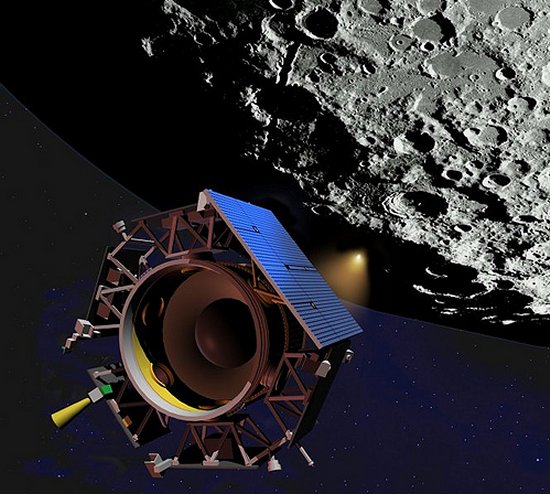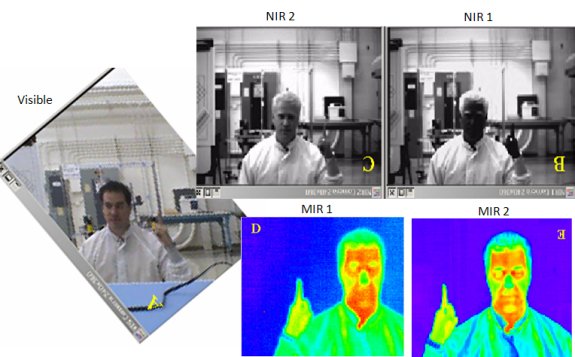Tony Colaprete, chief scientist for LCROSS, on how a lot of wavelengths will lead to a better understanding of lunar soil.

LCROSS is going someplace we have never been before: a permanently shadowed crater at the south pole of the moon. The trip is being made to study the source of hydrogen that has been measured at the lunar poles by the previous Lunar Prospector mission. LCROSS will make an impact into the floor of a shadowed crater so that some of the lunar soil in the crater will be lifted into sunlight…the first sunlight it will have seen in perhaps one or two billion years.
When the lunar soil, the ejecta of the impact, reaches sunlight a variety of observatories and instruments will make measurements. There are a variety of theories regarding the source of the hydrogen including it being in the form of water ice, adsorbed water (chemically bound to lunar grains), hydrated minerals, hydrocarbons, or even captured solar protons.
Since we really don’t know the source of the hydrogen signature, the LCROSS mission looks across a broad range of possibilities, making a variety of measurements that address as many of the possibilities as possible. Measurements are made from the LCROSS shepherding spacecraft from the ultraviolet wavelengths to thermal wavelengths, taking images as well as spectroscopic measurements. Combining all these measurements will help us understand the composition and properties of shadowed lunar soil in the most unambiguous way.
Here I am below, seen from the five cameras on the LCROSS shepherding spacecraft:


I hope that you/we find water under the every moon crater.
While in Vietnam I watched Appolo 11 live (AFVN-TV) recorded the event
on my Teac 4010 tape deck and was totally fasinated with the event.
Find water and we have a great jimp off spot for exploring our other planets and moons.
I would like to see some sort of rescue vehicle landed ahead of any
maned exploration. Plus have some sort of vehicle in orbit possibly on a permanent basis prior to ground exploration. The moon might be the
exception.
I think I was born too soon. Fantastic effort being put out. Oh yeah,
think ahead, don’t sink the eight ball. (You know the pilot who lines up his disabled commercial airliner on the runway only to discover when he throttles back to land the plane changes it’s direction and lands (fortunately) in a field.
NASA i will admiare ur effort for whole world.I suggest u to “Plz plant some TREE on MOON and take a observation on tree”. If tree will live it will automatically generate Oxigen
please sent the more then information of the sattelite
I�m not from the US but I�m exited with the possibility of finding water or the components to make water on the moon, which could lead the way for the expansion of man kind through the galaxy and eventually beyond. I wish this could be a worldwide effort, and applaud your initiative at NASA. GO AHEAD TO THE MOON AND BEYOND!!!!
How do you know that the impact on the moon will not disturb its orbit? Should we regard it as a resource for exploitation or is it not far more important as it is now – a vital part of the way the earth is; the weather, the ocean tides: how much more does the moon do for us? Have you thought about the risk of disturbing its orbit?
I really do not understand why we have to do this. Why use 79 million dollars of taxpayers money (the cost of the ship) to hit the moon and destroy the ship. There are plenty more useful things in this world to use that money on that can help us immensely, but yet we are using it to crash into the moon. Why bother something that is not messed up, bothering us, and in perfect condition. What if we are to hit the moon and is does more damage to the moon that what we thought would happen? Orbit issues, a huge crack in the moon, who knows! Im sure that there will be plenty that criticize me about this post but really is it necessary that we do this? Not hardly.
Just right.
Is there water on the moon? Does the space station grow plants for O2? If they can generate electricity, most suredly the space station could use plant grow lights. Do they do this? I’d be interested.
Regards
Is there water on the moon? Does the space station grow plants for O2? If they can generate electricity, most suredly the space station could use plant grow lights. Do they do this? I’d be interested.
Regards
Thanks for this particularly helpful article. Can you kindly confirm if there has been any other larger cracks, clefts, or linear cleavage on the surface of the moon spotted by the lunar orbiting satellites? Please send me a copy of your response on the e-mail address above. Thank you very much!
i really love to study the moon!